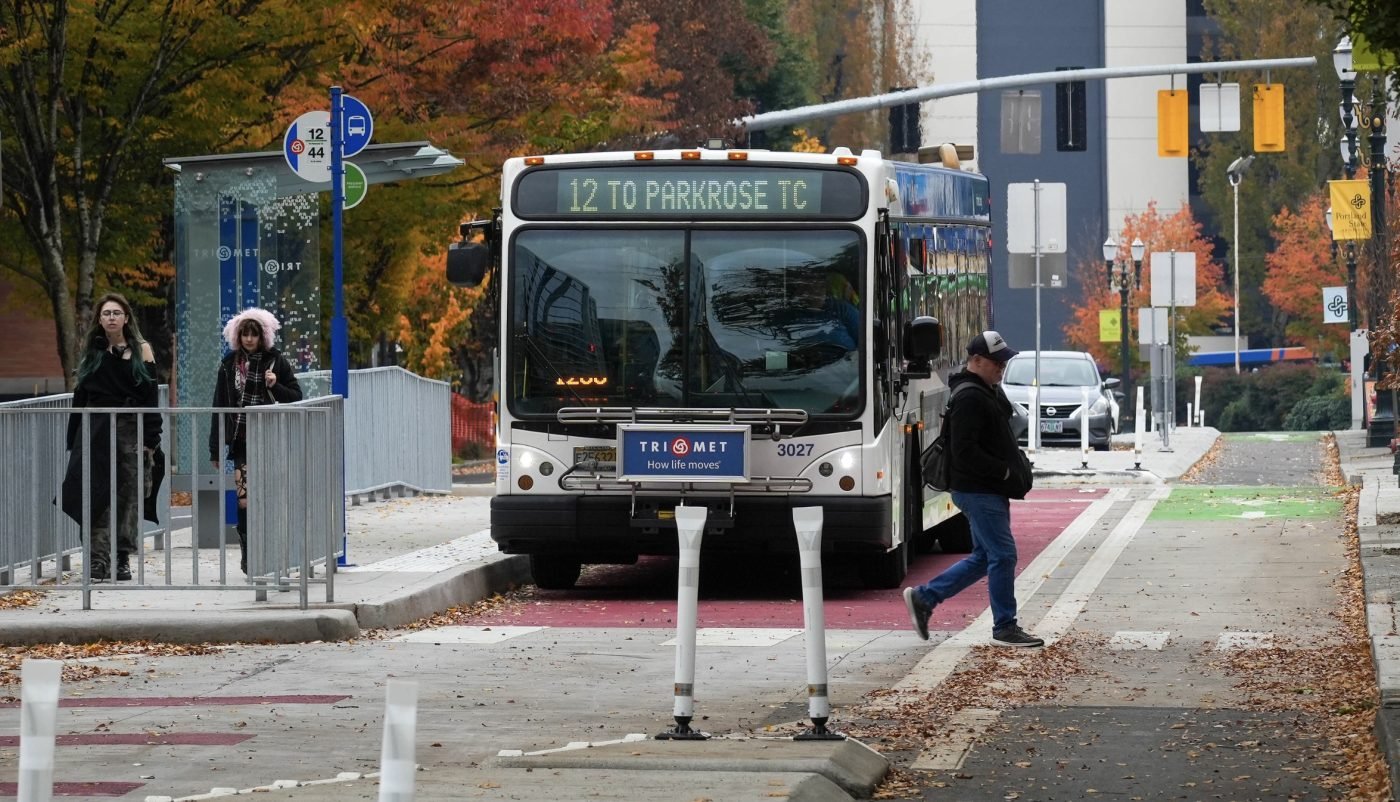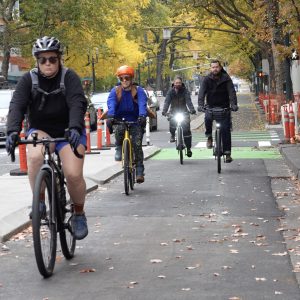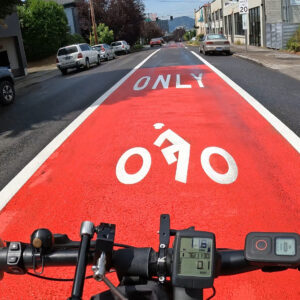
Turns out that when given a clean slate and a proper budget to update a major central city corridor, the City of Portland is actually quite good at what they do. From everything I’ve heard so far, the new protected bike lane on SW 4th Avenue is a big success. Folks love it. And trust me, if it wasn’t working, I’d hear about it.
While my coverage focused mostly on what it means for the bike network, the SW 4th project is also a huge win for transit. Yesterday, TriMet highlighted (see video below) how buses are now faster and more reliable due to the new “Rose Lane” (remember those!?).
The main thing this new lane does is give bus operators more room to zoom. They no longer have as many car users getting in their way and the operations are smoother due to high tech signal upgrades. But there are three other things TriMet and the Portland Bureau of Transportation did that are worth highlighting: they built a cool new bus platform, they made the bus lane out of concrete, and they made buses safer to access.
The new bus stop on SW 4th between Hall and Harrison (used by Line 12 and Live 44) is now in the middle of the roadway — between the new protected bike lane and other lanes. The location of the platform allows bus operators to stay in the center of the roadway to service the stop, without conflicting with car or bike users. This is both safer and more efficient.
And given that buses weigh 7-10 times as much as an average car and do much more damage to the pavement as a result, the new lane was constructed with reinforced concrete. You’ll see small pads of this concrete at busy bus stops citywide, but PBOT and TriMet went whole hog with it on SW 4th. This means the bus lane is a smart investment because it will last much longer than standard pavement.
The other element of this project that’s great for transit (and walkers and bikers too) are all the new safety features: new crossings with signal upgrades, a bunch of concrete median islands that calm traffic and shorten crossing distances, and street lighting upgrades.
This is such an exciting project. It’s the most complete and well-executed example of quality bike and bus infrastructure in the city. For years I’ve been begging PBOT to build something like this so we have something tangible and local to point to and say, “See, this is what we are talking about. This is what we need more of.” Once we build a network of streets similar to this, city goals that currently feel out of reach will begin to feel inevitable.
PBOT is very close to opening the entire project all the way to Burnside. Stay tuned and keep that feedback rolling in to temper my enthusiasm with reality.





Thanks for reading.
BikePortland has served this community with independent community journalism since 2005. We rely on subscriptions from readers like you to survive. Your financial support is vital in keeping this valuable resource alive and well.
Please subscribe today to strengthen and expand our work.
I’d never want to temper your enthusiasm Jonathan, love to see good things happen like this!
Concrete compared to asphalt generally lasts a lot longer, can resist cracking and heavy loads better, but on the downside it’s a lot more expensive and its ingredients, particularly the lime production, are major contributors to greenhouse gases and global warming. A lot of cities now use “warm asphalt” as being both permeable to rain and runoff, and is usually at least partly made of recycled asphalt (sometimes entirely), mitigating some of the bad externalities of using fossil fuel based materials.
I grew up in a community (Grand Forks ND) that only built streets and sidewalks out of concrete, then later cover some of the concrete with a layer of asphalt to smooth out the cracks on the streets. All development had to have their (concrete) streets and sidewalks put in before any foundations could go in. Sure it made it expensive to build stuff in my town, but all developers and city officials simply got used to it. The city of Fargo, 75 miles down south on I-29, built all their roads with asphalt and didn’t necessarily require sidewalks, and houses were significantly cheaper, but the roads were beat up every year from the winter deep freeze and spring thaws and looked like crap, with huge sidewalk gaps.
In Portland, most of the state and county-built highways were concrete overlayed with asphalt, a few re-enforced with rebar, and some were “MacAdamized”, gravel with concrete poured on top back in the 1920s and 30s, but most city streets including in annexed areas are asphalt on layers of rock, sand and gravel.
If there’s any good to come with the federal shenanigans, it’s that Portland/Multnomah/Metro will no longer be tied to federal standards written by GM and Ford. Easier to build exactly what you want if you don’t have to worry about the strings attached to your money. The only downside is coming up with that money.
Is there anything in this project that doesn’t meet MUTCD or AASHTO standards?
It’s nice that they painted some lanes red on SW 4th but it really sucks that the rose lane markings were removed on Martin Luther King from Broadway to the convention center.
hilarious soren. It’s really so hard for you to compliment them that you have to whatabout this. Just take the “W”!
Fine:
The rose lanes on SW 4th are awesome. We need more of this on every arterial.
_ _ _ _ _ _ _ _ _ _ _ _ _ _ _ _ _ _
_ _ _ _ _ _ _ _ _ _ _ _ _ _ _ _ _ _
Why were the rose lane markings removed on Martin Luther King from Broadway to the convention center?
I don’t detect whataboutism – just that soren is sad about losing his rose lane. That’s legit.
That section of MLK was recently repaved and last time I was there (admittedly a few weeks ago) they hadn’t yet repainted the permanent lane markings. Has that been done yet?
The permanent markings were painted 3-4 weeks ago. And, of course, this lane is now being heavily used by non-transit traffic during peak hours.
One thing you probably don’t know, since you don’t ride the #12 and #44 buses regularly, is that bus drivers are having a tough time negotiating the narrow, curb-protected lane, especially around the new island. If you’re riding the bus you need to hang onto your phone with both hands or risk having it fly to the floor when the bus bumps over the curb and settles back down.
I’m guessing they didn’t consult the bus drivers when they built the narrow lane.
Otherwise I agree with your assessment of the rose lane on 4th: it’s a big improvement.
It’s at Mill Street – they have to veer into the center lane (left car lane) to even attempt the turn without hitting the infrastructure.